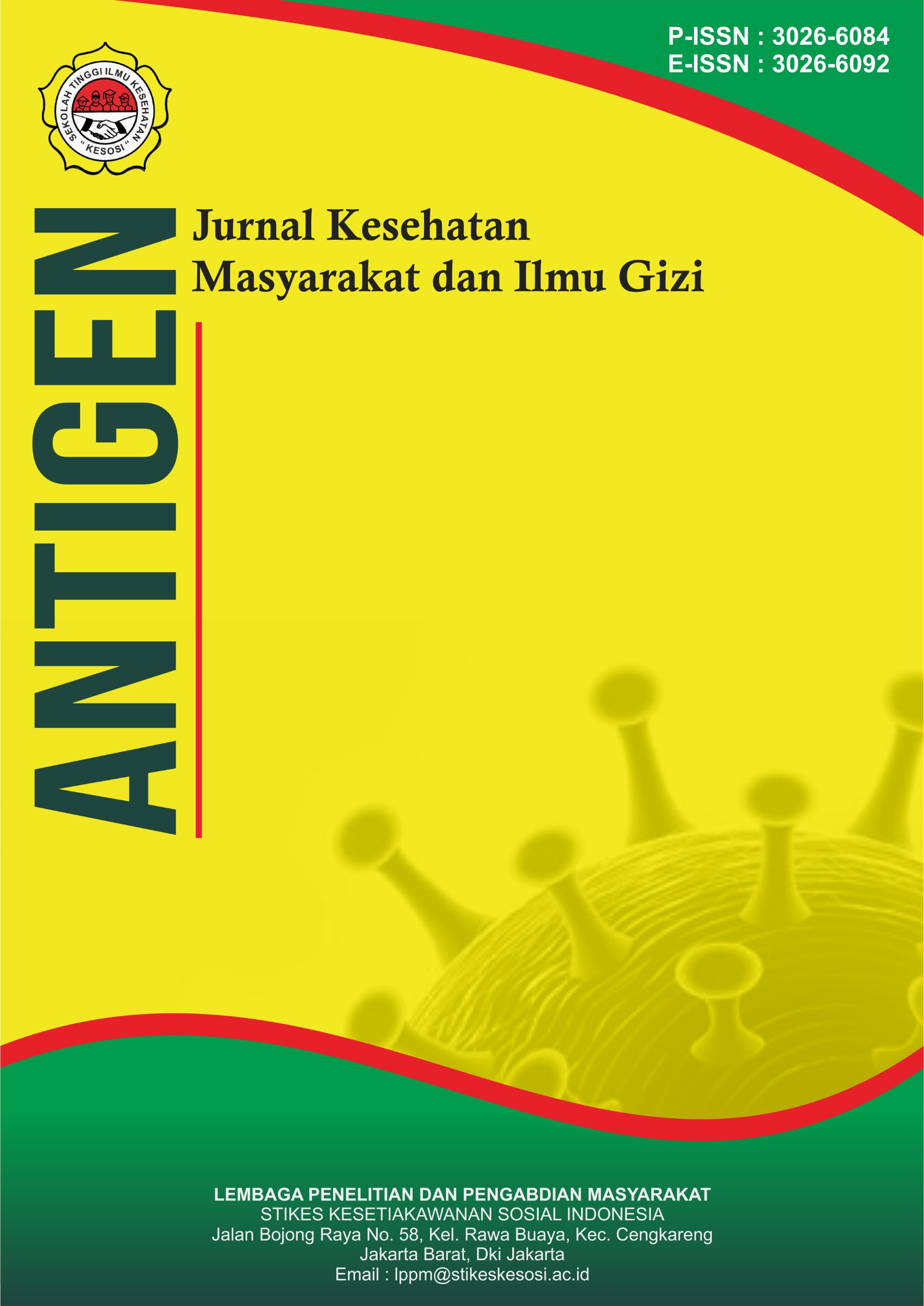Literatur Review: Pengaruh Fitosterol terhadap Penurunan Kadar Kolesterol LDL dalam Darah
DOI:
https://doi.org/10.57213/antigen.v3i3.809Keywords:
cholesterol reduction, cholesterol, LDL, phytosterol, β-sitosterolAbstract
Excessive fat consumption can lead to increased cholesterol levels in the body, which in turn can trigger various serious health problems, including heart disease, blood vessel blockage, and even stroke. Blood cholesterol consists of two main types: LDL (Low-Density Lipoprotein) cholesterol, often referred to as bad cholesterol, and HDL (High-Density Lipoprotein) cholesterol, which plays a role in transporting cholesterol from the blood vessels to the liver for excretion. Elevated LDL cholesterol levels can cause plaque buildup on blood vessel walls, which narrows blood flow and increases the risk of various cardiovascular diseases. One method considered effective for lowering LDL cholesterol levels in the blood is by consuming phytosterols, compounds found naturally in various types of plants. Phytosterols have a structure similar to cholesterol and can compete with cholesterol for absorption in the intestine. This results in a decrease in the amount of cholesterol entering the body, thereby reducing total cholesterol levels and especially LDL cholesterol in the blood. Research shows that giving food or supplements containing about 3 grams of phytosterols per day to human subjects can reduce LDL cholesterol levels by up to 15%. Furthermore, phytosterols directly isolated from plants, such as green beans, have also been shown to significantly lower LDL cholesterol levels. Studies in mice fed phytosterols isolated from green beans showed a reduction in blood LDL cholesterol levels of more than 30%. This demonstrates the potential of phytosterols as a natural ingredient that can be used to support cholesterol management in the body. Although phytosterols have significant potential in lowering cholesterol levels, it is important to remember that consuming supplements or foods containing phytosterols should be done under the supervision and recommendation of a medical professional, especially for individuals with certain medical conditions or who are taking medications.
References
Adji, D. (2008). Hubungan Konsentrasi Malondialdehida, Glukosa dan Total Kolesterol pada Tikus Putih yang Diinjeksi dengan Streptozotocin (pp. 74–77).
Barkas, F., Bathrellou, E., Nomikos, T., Panagiotakos, D., Liberopoulos, E., & Kontogianni, M. D. (2023). Plant Sterols and Plant Stanols in Cholesterol Management and Cardiovascular Prevention. Nutrients, 15(13). https://doi.org/10.3390/nu15132845
Feng, S., Belwal, T., Li, L., Limwachiranon, J., Liu, X., & Luo, Z. (2020). Phytosterols and their derivatives: Potential health-promoting uses against lipid metabolism and associated diseases, mechanism, and safety issues. Comprehensive Reviews in Food Science and Food Safety, 19(4), 1243–1267. https://doi.org/10.1111/1541-4337.12560
Fontané, L., Pedro-Botet, J., Garcia-Ribera, S., Climent, E., Muns, M. D., Ballesta, S., Satorra, P., Flores-Le Roux, J. A., & Benaiges, D. (2023). Use of phytosterol-fortified foods to improve LDL cholesterol levels: A systematic review and meta-analysis. Nutrition, Metabolism and Cardiovascular Diseases, 33(8), 1472–1480. https://doi.org/10.1016/j.numecd.2023.04.014
Ino, N., Yuszda, I., Salimi, K., & Botutihe, D. N. (2017). Biokimia Dasar.
Jati, B. N., Yunilawati, R., Nuraeni, C., Oktarina, E., Aviandharie, S. A., & Rahmi, D. (2019). Ekstraksi dan Identifikasi Fitosterol pada Mikroalga Nannochloropsis occulata. Jurnal Kimia Dan Kemasan, 41(1), 31. https://doi.org/10.24817/jkk.v41i1.4969
Rawal, G., Yadav, S., & Nagayach, S. (2015). Phytosterols and the health. Medico Research Chronicles, 2(3), 441–444.
Schoeneck, M., & Iggman, D. (2021). The effects of foods on LDL cholesterol levels: A systematic review of the accumulated evidence from systematic reviews and meta-analyses of randomized controlled trials. Nutrition, Metabolism and Cardiovascular Diseases, 31(5), 1325–1338. https://doi.org/10.1016/j.numecd.2020.12.032
Sugijanto, N. E. N., Makayasa, C. H. A., Deseria, G., Bridgeta, R. A. I., Putri, M. R., Setiawan, C. D., & Sugijanto, S. (2020). Identifikasi Pengaruh Proses Perebusan dan Penggorengan Kacang Tolo (Vigna unguiculata L. Walp.) terhadap Komposisi Fitosterol. Jurnal Farmasi Dan Ilmu Kefarmasian Indonesia, 7(1), 7. https://doi.org/10.20473/jfiki.v7i12020.7-18
Sulastri, L., Syafalia, P., & Fauzi Isa, A. (2020). Pengaruh Fraksinasi Buncis (Phaseolus Vulgaris L.) Terhadap Penurunan Kadar Kolesterol Tikus Putih (Rattus Norvegicus L.) Yang Hiperkolesterolemia. Jurnal Farmamedika (Pharmamedica Journal), 5(1), 14–20. https://doi.org/10.47219/ath.v5i1.90
Susiwati, RS, S., & Farizal, J. (2018). Analisis Kolesterol Low Density Lipoprotein (Ldl) Pada Pengkonsumsi Produk Minuman Herbal Kota Bengkulu Tahun 2017. Journal of Nursing and Public Health, 6(2), 95–99. https://doi.org/10.37676/jnph.v6i2.661
Untono, R. H., Nugraha, J., Gde Rurus Suryawan, I., & Andrianto. (2022). Non-HDL Cholesterol and LDL Cholesterol as Main Risk Factors for Coronary Heart Disease: Meta-Analysis. Indonesian Journal of Clinical Pathology and Medical Laboratory, 28(3), 231–237. https://doi.org/10.24293/ijcpml.v28i3.2006
Vaquero, M. P., Muniz, F. J. S., Redondo, S. J., Oliván, P. P., Higueras, F. J., & Bastida, S. (2010). Major diet-drug interactions affecting the kinetic characteristics and hypolipidaemic properties of statins. Nutricion Hospitalaria, 25(2), 193–206. https://doi.org/10.3305/nh.2010.25.2.4405
Wahjuni, S., Rustini, N. L., & Yuliantari, P. (2016). PEMBERIAN EKSTRAK ETANOL BUAH BUNCIS (Phaseolus vulgaris L.) UNTUK MENURUNKAN KOLESTEROL TOTAL, Low Density Lipoprotein (LDL) DAN MENINGKATKAN High Density Lipoprotein (HDL) PADA TIKUS WISTAR DIET TINGGI LEMAK. Jurnal Kimia, Ldl, 103–109. https://doi.org/10.24843/jchem.2016.v10.i01.p14
Downloads
Published
Issue
Section
License
Copyright (c) 2025 Antigen : Jurnal Kesehatan Masyarakat dan Ilmu Gizi

This work is licensed under a Creative Commons Attribution-ShareAlike 4.0 International License.






